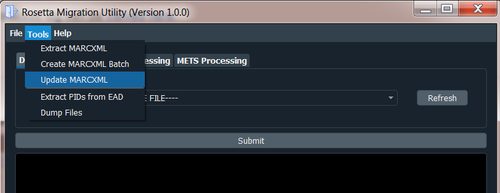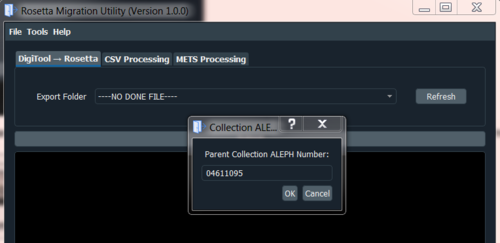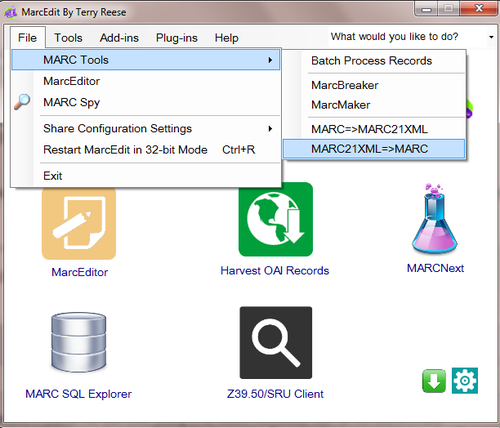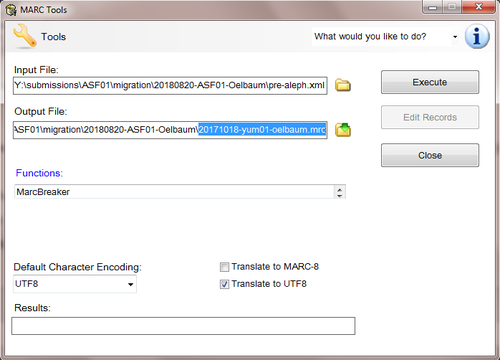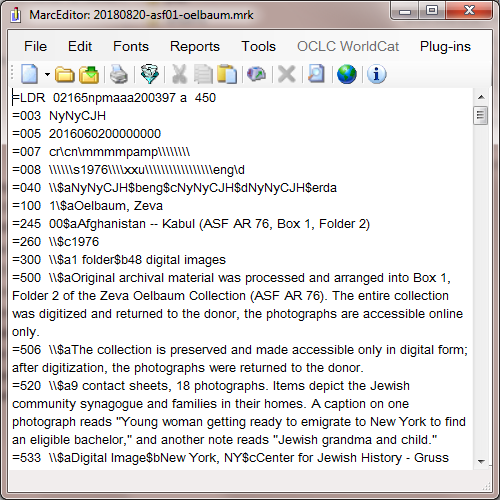DigiTool Migration Workflow: Difference between revisions
Jump to navigation
Jump to search
No edit summary |
No edit summary |
||
| Line 9: | Line 9: | ||
==Export from DigiTool== | ==Export from DigiTool== | ||
'''1. Make sure you are connected to the correct Admin Unit''' | |||
*DigiTool → Connect To | |||
'''2. Start Export Digital Entities Job''' | |||
*Management → Maintenance → Submit New Job | |||
*Choose Export Digital Entities from list | |||
*Search for collection and/or objects to be migrated | |||
*Click Next | |||
*Set the Export directory | |||
**'''[YYYYMMDD]-[PartnerCode]-[DescriptiveText]''' | |||
**'''[YYYYMMDD]''' is the date format. | |||
***E.g. 20180816 = August 16th, 2018 | |||
**'''[PartnerCode]''' | |||
***AJH01 | |||
***ASF01 | |||
***LBI01 | |||
***YIV01 | |||
***YUM01 | |||
**'''[DescriptiveText]''' can be the call number, name of collection, a simple description, etc. | |||
*** Example: '''20180816-AJH01-JJLYONS''' | |||
*Add sequential number to end of folder name if exporting in batches | |||
*** Example: '''20180816-AJH01-JJLYONS-001''' | |||
*Set Format to “Digital Entities” | |||
*'''DE-SELECT''' the “Include Streams” and “Export Related Objects” boxes | |||
*Click Next | |||
*Click Confirm | |||
'''3. Monitor the Export job''' | |||
* Management → Maintenance → Monitor | |||
'''4. Merge batches if exporting in batches''' | |||
* Make sure all batches have completed exporting | |||
* Use [[Rosetta_Deposit_Processor_Tools#Merge_Batches | Merge Batches Tool]] in Rosetta Migration Utility. | |||
'''5. Save Export job log once job is complete''' | |||
* Search for Job log | |||
* Management → Maintenance → Jobs List | |||
** Job Name = Export Digital Entities | |||
** Admin Unit = Partner whose objects are being exported | |||
** Job Status = Completed | |||
* Click eye icon under “Action” on the far left | |||
* In the pop up window, choose “Log” | |||
* Click eye icon under “Action” on the far left | |||
* Copy and paste contents of log into text document and save with the name of the export folder. | |||
** [YYYYMMDD]-[PartnerCode]-[DescriptiveText].txt | |||
* Save file '''on Rosetta server''' at [PartnerCode]/migration/migration_logs | |||
'''6. Move DigiTool export to Rosetta server''' | |||
* TBD | |||
'''7. Write Migration Note in DigiTool''' | |||
* Management → Maintenance → Submit New Job | |||
* Choose Assign Control Attributes from list | |||
* Search for objects to update, click Next | |||
* Parameters for job: | |||
** Name = Partition C | |||
** Value = ROS_YYYY_MM | |||
==Processing== | ==Processing== | ||
Revision as of 22:59, 29 January 2019
Developed by Kevin Powell in 2018 to migrate Center for Jewish History assets from DigiTool to Rosetta.
Requirements
- Mapped Network Drive to at least one of the partners' Rosetta submission folders
- /storage1/operational_shared/submissions/[PARTNER_CODE]
- Mapped Network Drive to DigiTool server
- /storage6/bigstreams6/dtl-export
- Access to the Export Digital Entities job in DigiTool for at least 1 admin unit
Export from DigiTool
1. Make sure you are connected to the correct Admin Unit
- DigiTool → Connect To
2. Start Export Digital Entities Job
- Management → Maintenance → Submit New Job
- Choose Export Digital Entities from list
- Search for collection and/or objects to be migrated
- Click Next
- Set the Export directory
- [YYYYMMDD]-[PartnerCode]-[DescriptiveText]
- [YYYYMMDD] is the date format.
- E.g. 20180816 = August 16th, 2018
- [PartnerCode]
- AJH01
- ASF01
- LBI01
- YIV01
- YUM01
- [DescriptiveText] can be the call number, name of collection, a simple description, etc.
- Example: 20180816-AJH01-JJLYONS
- Add sequential number to end of folder name if exporting in batches
- Example: 20180816-AJH01-JJLYONS-001
- Set Format to “Digital Entities”
- DE-SELECT the “Include Streams” and “Export Related Objects” boxes
- Click Next
- Click Confirm
3. Monitor the Export job
- Management → Maintenance → Monitor
4. Merge batches if exporting in batches
- Make sure all batches have completed exporting
- Use Merge Batches Tool in Rosetta Migration Utility.
5. Save Export job log once job is complete
- Search for Job log
- Management → Maintenance → Jobs List
- Job Name = Export Digital Entities
- Admin Unit = Partner whose objects are being exported
- Job Status = Completed
- Click eye icon under “Action” on the far left
- In the pop up window, choose “Log”
- Click eye icon under “Action” on the far left
- Copy and paste contents of log into text document and save with the name of the export folder.
- [YYYYMMDD]-[PartnerCode]-[DescriptiveText].txt
- Save file on Rosetta server at [PartnerCode]/migration/migration_logs
6. Move DigiTool export to Rosetta server
- TBD
7. Write Migration Note in DigiTool
- Management → Maintenance → Submit New Job
- Choose Assign Control Attributes from list
- Search for objects to update, click Next
- Parameters for job:
- Name = Partition C
- Value = ROS_YYYY_MM
Processing
- Open Rosetta Deposit Processor
- If the migration deposit DOES NOT require a complex structMap:
- Processor Migration Workflow
- CSV Template = template found here
- Export Folder = /[PartnerCode]/migration/[YYYYMMDD]-[PartnerCode]-[DescriptiveText]
- Move newly created deposit folder to /[PartnerCode]/CSV
- If the migration deposit DOES require a complex structMap:
- Processor Migration Workflow - Complex
- Export Folder = /[PartnerCode]/migration/[YYYYMMDD]-[PartnerCode]-[DescriptiveText]
- Move newly created deposit folder to /[PartnerCode]/METS
ALEPH Reconciliation
If the Deposit Processor extracted MARC records from the DigiTool export, open a sample amount to see if they have ALEPH system numbers in the 001 controlfield. If they do not have ALEPH system numbers, they need to be added to ALEPH:
- Create MARCXML Batch from extracted MARC records.
- Open the Rosetta Deposit Processor and go to Tools --> Migration Tools --> Update MARC. Locate the MARCXML Batch.
- If these MARC records are associated with a parent collection, add the ALEPH System Number for that parent collection in the pop up window.
- Once the batch has been updated, open MarcEdit. Go to File --> MARC Tools --> "MARC21XML => MARC"
- Under Input File supply the path to the updated MARCXML batch file.
- Under Output File supply a path for a new .MRC file.
- Use the [YYYYMMDD]-[PartnerCode]-[DescriptiveText] naming convention, but make sure it is entirely in lower case. Aleph does not like capital letters in input file names.
- Make sure UTF-8 is chosen as Default Character Encoding
- Click Execute
- After the MRC file is created, double click it. This will open MARC Edit again and prompt you to create a human-readable MRK file.
- Open the MRK file to double check the MARC records. Make sure there aren't two leaders in a record.
- If there are two leaders, contact the Rosetta Systems Administrator
- If the MRC file is ready to go, upload it to this location on the ALEPH server
- /exlibris/aleph/u22_1/cjh01/scratch
- Open Aleph and, follow ~ THIS GUIDE ~ for adding records.
- Write down the name of the log file created during the manage-18 job. This can be used in the next step as the input file.
- Once the records are added, follow ~ THIS GUIDE ~ for downloading MARCXML from ALEPH.
- Use the commands below to add Aleph System Numbers to a copy of the original deposit CSV.
- If successful, the script will create an edited version of the original deposit CSV with the ALEPH system numbers added.
- If the edited Deposit CSV is correct, move the original CSV to another location.
Adding ALEPH system numbers to deposit CSV
- Open Command Prompt
- cd into the directory containing add_aleph_sys.py
C:\> cd C:\Path\To\script C:\Path\To\script> py -3.5 Python 3.5.0 on win32 >>> from add_aleph_sys import * >>> csvfile = r'C:\Path\To\DepositCSV.csv' >>> xmlfile = r'C:\Path\To\DownloadedAlephXML.xml' >>> add_aleph_num_CSV(csvfile, xmlfile) >>> 'C:\Path\To\EDITED_DepositCSV.csv'
Rosetta Ingest
- Copy the [YYYYMMDD]-[PartnerCode]-[DescriptiveText]_deposit folder to the appropriate submissions folder.
- For the simple Migration workflow (CSV)
- submissions\[PartnerCode]\CSV
- For the complex Migration workflow (METS)
- submissions\[PartnerCode]\METS
- For the simple Migration workflow (CSV)
